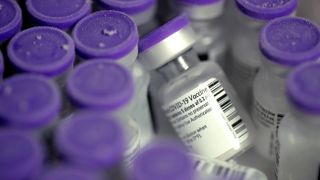COVID-19 vaccines: What does 95% efficacy actually mean?

You have likely heard that Pfizer's COVID-19 vaccine efficacy is 95%, Moderna's is 94% and Johnson & Johnson's is 66%. But what do these numbers actually mean?
It's not just an academic question. How people understand these numbers affects how they think about the vaccine, whether they get it and how they behave after getting it, all of which have implications for the pandemic on a larger scale.
So how should people interpret these numbers?
Related: Quick guide: COVID-19 vaccines and how they work
"I think it's important for people to understand that this is an extremely effective vaccine," said Brianne Barker, a virologist at Drew University in New Jersey, referring to the Pfizer vaccine. "This is much more effective than you might think."
One common misunderstanding is that 95% efficacy means that in the Pfizer clinical trial, 5% of vaccinated people got COVID. But that's not true; the actual percentage of vaccinated people in the Pfizer (and Moderna) trials who got COVID-19 was about a hundred times less than that: 0.04%.
What the 95% actually means is that vaccinated people had a 95% lower risk of getting COVID-19 compared with the control group participants, who weren't vaccinated. In other words, vaccinated people in the Pfizer clinical trial were 20 times less likely than the control group to get COVID-19.
That makes the vaccine "one of the most effective vaccines that we have," Barker told Live Science. For comparison, the two-dose measles, mumps and rubella (MMR) vaccine is 97% effective against measles and 88% effective against mumps, according to the Centers for Disease Control and Prevention (CDC). The seasonal flu vaccine is between 40% and 60% effective (it varies from year to year, depending on that year's vaccine and flu strains), but it still prevented an estimated 7.5 million cases of the flu in the U.S. during the 2019-2020 flu season, according to the CDC.
So, if efficacy means some percent fewer cases of COVID-19, what counts as a "case of COVID"? Both Pfizer and Moderna defined a case as having at least one symptom (however mild) and a positive COVID-19 test. Johnson & Johnson defined a "case" as having a positive COVID-19 test plus at least one moderate symptom (such as shortness of breath, abnormal blood oxygen levels or abnormal respiratory rate) or at least two milder symptoms (such as fever, cough, fatigue, headache, or nausea). Someone with a moderate case of COVID-19 by this definition could either be mildly affected or be incapacitated and feel pretty sick for a few weeks.
Barker cautions that it’s tricky to directly compare efficacy between the Johnson & Johnson, Pfizer, and Moderna vaccines, because the clinical trials happened in different geographic areas with different populations, and at slightly different time points in the pandemic when different variants of COVID-19 were circulating. “There were more people who had the B117 [U.K. variant] or other types of variants during the time of the Johnson & Johnson trial than during the Moderna trial,” she said.
And none of the three vaccine trials looked at all for asymptomatic COVID-19. "All these efficacy numbers are protection from having symptoms, not protection from being infected," Barker said. (Some early studies hint that the Pfizer and Moderna vaccines also reduce the number of viral particles in a person's body, called viral load, and the likelihood of testing positive at all, which would cut transmission. Still, because we don't yet know that for sure, people "can't throw away their mask" once they're vaccinated, Barker said.)
But all three trials also used a second, potentially more important, definition of "cases." What we care most about is protecting people from the worst outcomes of COVID-19: hospitalization and death. So Moderna, Pfizer and Johnson & Johnson also measured how their vaccines performed against severe disease (which meant severely affected heart or respiratory rate, the need for supplemental oxygen, ICU admission, respiratory failure or death).
All three vaccines were 100% effective at preventing severe disease six weeks after the first dose (for Moderna) or seven weeks after the first dose (for Pfizer and Johnson & Johnson, the latter of which requires only one dose). Zero vaccinated people in any of the trials were hospitalized or died of COVID-19 after the vaccines had fully taken effect.
"We are incredibly lucky with how effective these vaccines have been," Barker said.
Originally published on Live Science.
https://www.livescience.com/covid-19-vaccine-efficacy-explained.html?utm_source=pocket-newtab